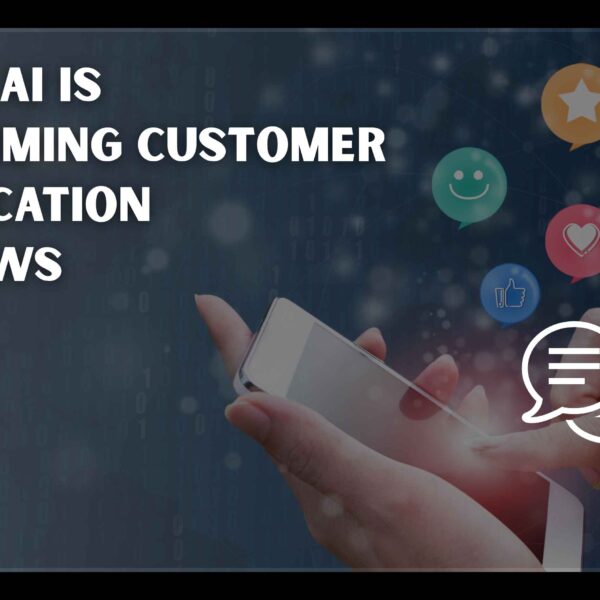Customer communication has always been the backbone of successful businesses. But the way brands engage with customers has changed dramatically — evolving from one-way email blasts to intelligent, real-time conversations powered by AI. Today’s automated customer communication isn’t just about efficiency — it’s about personalization and prediction. Let’s explore how this evolution unfolded — and what it means for businesses embracing automation.
The Early Days: Manual and Email-Based Communication
In the early 2000s, email marketing emerged as the first major leap toward automation. Businesses began using bulk mailing tools like Mailchimp and Constant Contact to send newsletters, product updates, and promotions.
While revolutionary at the time, this method was still one-directional.
- There was no personalization,
- No behavioral triggers, and
- No real feedback loop from the customer side.
Email campaigns relied on lists, not relationships — leading to the rise of spammy outreach and declining engagement over time. Still, this stage laid the groundwork for the first generation of automated customer communication — showing how software could replace repetitive human effort in messaging.
The Shift to Trigger-Based Automation
By the mid-2010s, businesses realized the importance of context. Enter trigger-based automation — systems that sent messages based on user actions or events.
For example:
- Sending a welcome email right after signup
- Reminding users about an abandoned cart
- Following up when a trial was about to expire
Platforms like Customer.io, Iterable, and HubSpot led this transformation. Instead of sending mass emails, marketers began creating communication flows that responded to user behavior in real time.
This shift marked a key turning point — automated communication was no longer just about marketing; it was about building personalized relationships at scale.
The Omnichannel Communication Era
As digital touchpoints multiplied, email alone wasn’t enough. Customers wanted to interact through:
- SMS and WhatsApp
- In-app notifications
- Chatbots and live chat
- Push notifications and social DMs
Omnichannel tools reshaped customer communication automation, bringing consistency across platforms. Businesses adopted omnichannel automation tools that could synchronize these channels into a unified experience.
For instance, a customer could:
1. Receive an email confirmation,
2. Get a WhatsApp update, and
3. Talk to a chatbot for quick support — without feeling disconnected between each step.
Tools like Intercom, Twilio, and Zendesk powered this shift. They offered real-time synchronization, ensuring brands could deliver consistent messaging across multiple platforms.
The goal evolved from “sending messages” to creating continuous conversations.
Rise of Chatbots and Conversational Automation
Around 2018–2020, chatbots became the next leap in customer communication automation.
Powered by natural language processing (NLP), bots could now:
- Understand common customer questions
- Offer instant responses
- Escalate complex queries to human agents
Early chatbot platforms like Drift, ManyChat, and Chatfuel made automation feel more conversational. Instead of static emails or notifications, businesses began to “talk” to customers — even when support teams were offline.
This was the start of conversational automation, where the line between marketing, support, and sales began to blur.
The AI Revolution: From Reactive to Predictive Communication
In the 2020s, AI transformed communication from reactive to predictive. Instead of waiting for customer actions, systems began anticipating needs before users even expressed them.
AI-driven platforms now:
- Analyze historical data and behavior patterns
- Predict customer intent
- Personalize content, timing, and channel preference
For example:
- AI can identify users likely to churn and send targeted offers automatically
- Language models can write and adapt messages in a brand’s tone
- Voice AI agents can handle phone support with human-like fluency
This new phase of AI-powered customer communication is built on context, intent, and empathy — all at machine scale.
The Emergence of AI Agents: The Future Is Already Here
In 2025, we’re seeing the rise of autonomous AI agents — virtual team members capable of managing full communication cycles.
Unlike traditional chatbots, these agents:
- Learn continuously from interactions
- Integrate deeply with CRM, ERP, and analytics tools
- Coordinate with other agents (sales, support, marketing) to provide seamless experiences
They don’t just respond — they initiate intelligent conversations based on insights.
For example, an AI sales agent can follow up after a demo, update CRM notes, and book meetings — all autonomously. Similarly, an AI support agent can troubleshoot, summarize customer issues, and escalate when necessary.
This marks the transition from automated communication to autonomous communication ecosystems — where human oversight is minimal but the customer experience remains deeply personal.
The Business Impact of Modern Communication Automation
The evolution from emails to AI agents isn’t just about technology — it’s about business outcomes:
- Faster response times: Automated systems reply instantly, boosting satisfaction.
- Cost efficiency: Reduced reliance on large human teams.
- Scalability: Handle thousands of conversations concurrently.
- Consistency: Every customer receives an on-brand experience.
- Data intelligence: Insights from every interaction improve future engagement.
Companies embracing AI-led communication see higher retention, stronger relationships, and measurable ROI on engagement automation.
What’s Next
The next frontier is emotion-aware AI communication — systems capable of detecting customer sentiment in real time.
Imagine an AI agent that:
- Adjusts its tone if a user sounds frustrated
- Sends proactive help before a complaint arises
- Prioritizes empathy while maintaining efficiency
These systems combine machine learning, NLP, and sentiment analysis to humanize automation further. The result? Communication that’s automated yet feels deeply personal.
Conclusion
The journey from email to AI agents reflects more than a shift in tools — it’s a transformation in how businesses connect with people. Automation began as a way to save time but evolved into a means to build better, smarter, and more meaningful relationships at scale. As we enter the age of intelligent, adaptive AI agents, one thing remains clear: The most successful brands will be those that blend automation with authenticity, and technology with empathy.



